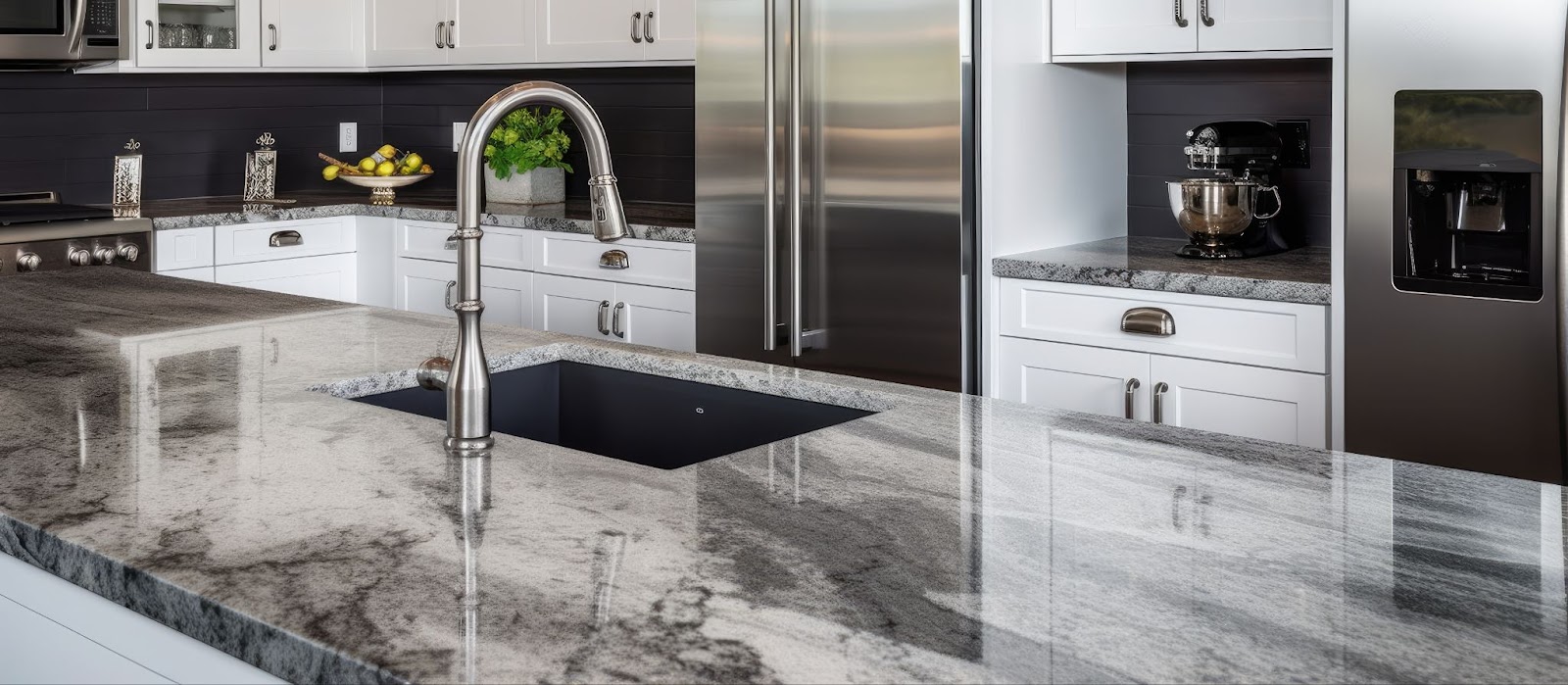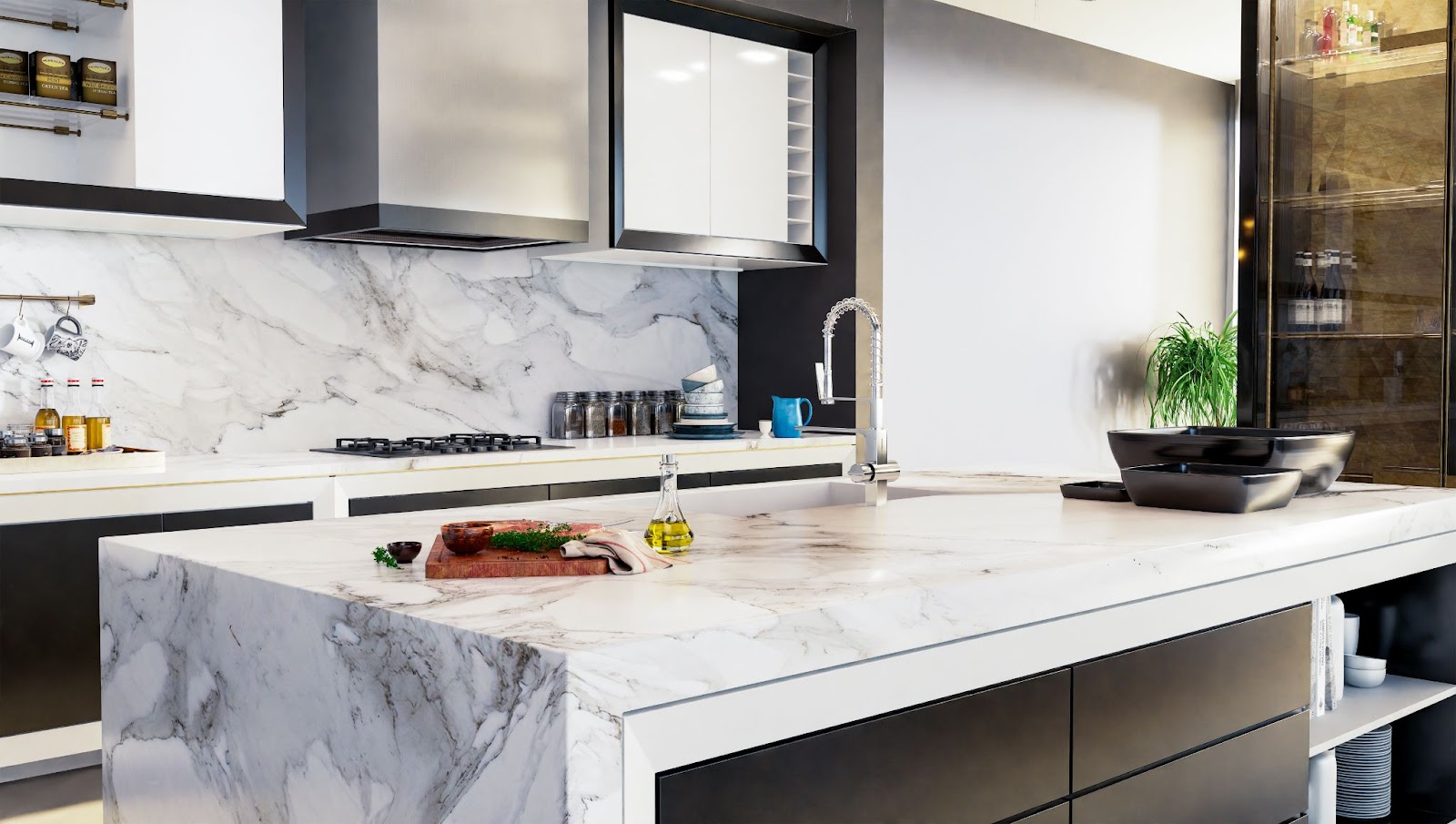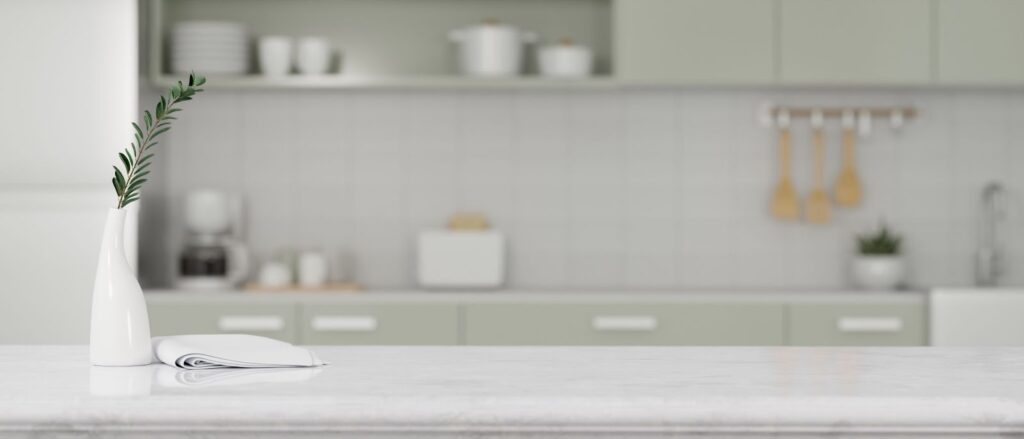Whether remodeling your kitchen or upgrading countertops, choosing the right material is essential for function and style. Formica™ and stone countertops are popular options, each with benefits and drawbacks. With your dreams and budget in mind, let’s review the pros and cons of Formica™ laminate countertops, granite stone countertops, and quartz stone countertops to make the right decision for your kitchen.
Formica™ countertops
Formica™ is a brand name of the original plastic laminate material used to make countertops. This blog will refer to Formica™ and laminate interchangeably to help describe the overarching type of countertop material.
The first step of any buyer’s guide is to know what laminate is. Laminate is made from paper! Sheets of kraft paper are saturated in resin and tightly pressed together under high heat. Then, decorative paper goes on top and cures in an oven. Lastly, the laminate sheets are glued onto particle boards to create your countertop.
This laminate countertop has been a staple for decades. It is easy to install and comes in a variety of designs, so let’s explore it further.
Advantages of Formica™ countertops
Cost-effective
Cost is one of the most significant advantages of laminate countertops over stone countertops. They are significantly less expensive than quartz or granite, making them affordable when working within a tight budget.
Affordability partly comes from the advantage of sustainability. Since laminate is produced from paper, Formica™ contains a minimum of 10% recycled content from certified sources.
Easy to install
Cost also extends past the material and applies to labor. Laminate is much lighter than stone and granite countertops, making installation much easier. The ease of installation reduces labor costs and minimizes the disruptions to your home during renovation.
There is a DIY option for installing your own countertop. In nine steps, you can save money and do the job efficiently with limited essential materials.
A variety of designs
Formica countertops have a printed design sheet attached to the particle board core. This manufacturing process makes it easy to provide various design options. Laminate comes in a wide variety of colors, patterns, and finishes. Five popular laminate styles include the eased edge, the bullnose edge, the beveled edge, and the ogee edge.
Laminate finishes also come in many options, from matte to high gloss. A stone finish can make your counter look like granite but save you money, allowing homeowners to customize their kitchen’s appearance.
Disadvantages of Formica™ countertops
Not durable
Known for its long-lasting appeal, Formica™ laminate countertops are stain resistant, but the material is not as easily repairable if something cracks, scratches, or breaks. Compared to stone and granite countertops, Formica™ countertops don’t last as long.
Laminate countertops can scratch more easily, and hot pans and pots can leave marks. Use cutting boards and hot pads to keep your countertop looking brand new. Unlike granite, laminate is also susceptible to chipping and burns. Although laminate countertops claim they last for decades, you can most likely expect to replace them every 10 years.
Aesthetic limitations
Although Formica™ offers a variety of designs, it lacks the depth, texture, and luxury of natural stone. For those seeking a high-end look, Formica™ may not meet aesthetic expectations. Laminate countertops don’t have the resale value that stone and granite countertops do.
Homebuyers sometimes prioritize appearance, and laminate kitchen countertops could aesthetically impact the overall property value of your home.

Granite stone countertops
Stone and granite countertops are luxurious but worth the investment. Quartz and granite are two of the most popular.
Granite is one of the leading kitchen countertop materials used for remodeled homes in the United States in 2023-2024. As a top choice for homeowners, granite stone countertops don’t show signs of waning and continue to be a strong choice for kitchens, bathrooms, and more. The appeal of granite stone countertops goes beyond mere aesthetics to offer practical benefits. When purchasing a granite stone countertop, the stone is quarried from around the world and a fabricator shapes it for you.
Advantages of granite stone countertops
Durability
Literally rock-hard, stone and granite countertops are durable and strong. Granite ranks right below diamonds in terms of hardness and does not scratch, chip, or break. This is perfect when chopping vegetables for dinner or kids are working on crafts for school at the central hub of activity. Entertaining becomes a breeze, too, without the worry of watching guests in your kitchen.
Granite is heat resistant, allowing you to place hot pots and pans directly on its surface without causing damage. There’s no need to invest in a plethora of pot holders. Since granite is formed in magma chambers of volcanoes and is created from pressure and heat itself, no sizzling pan can damage it. Being able to set a pan directly on your countertop makes for easier, more enjoyable cooking.
Minimal maintenance
You will be amazed by the minimal upkeep of a granite and stone countertop. Granite is one of the most durable materials that, with proper care, will not require much effort to stay in shape for many years.
The only maintenance required is re-sealing, which should be done every six to 12 months. This is necessary because granite is porous. Sealing it will prevent liquids from absorbing into your countertop.
Aesthetic appeal
A solid granite countertop is an attractive upgrade that changes the entire atmosphere of a room while increasing the value of your home. Each slab of granite has its own distinct patterns and colors. This ensures your space is special and gives it a one-of-a-kind aesthetic that adds to your stone’s attraction and value.
Disadvantages of granite stone countertops
They cost more
Unlike laminate, all stone and granite countertops are an investment for your home. Although granite is more expensive, you don’t need to worry too much about breaking the bank if this is the route you decide to take.
Complex installation
Granite countertops are heavy and, therefore, harder to install. HGTV states that you can save 20–30 percent if you install them yourself. However, it’s recommended that you contact a professional installer for help.
One difficulty in installing granite countertops is the precise measuring and fabrication. With stone cut and shaped to size, you cannot afford to make mistakes. With the heavy weight of granite, transportation and installation requires additional labor to lift.
Lastly, if you cannot get your countertop covered in one piece, granite countertops need to have seams to create a seamless look from slab to slab.

Quartz stone countertops
Quartz stone countertops have increased in popularity mainly due to their appearance. Granite and quartz are very similar countertops, but there are some important differences to note.
Quartz is a man-made product that uses natural materials. It is composed of roughly 90–95 percent quartz and five to 10 percent resins and pigments that form a hard and durable surface for your kitchen needs. Quartz looks like stone while allowing flexibility for different designs.
Advantages of Quartz stone countertops
Strength
Surprisingly, quartz is harder than granite. Therefore, it’s more durable — some say nearly indestructible. Because it’s engineered, quartz is not porous like granite. This makes it easy to keep countertops relatively bacteria-free and clean.
With this strength, the countertop will be resistant to scratches, chips, and cracks and will also withstand the daily hustle and bustle of your home.
Low-maintenance
Unlike natural stone, quartz doesn’t require sealing, which alone might be a big factor in your decision. Quartz is also easier to clean and maintain. When spills happen, soap and water or a household cleaner are all you need. The solid surface will not absorb the liquid.
Uniform appearances
Similar to laminate, quartz comes in many different colors and styles. For example, you’ll find colors from bright whites and creams to cool grays, rich browns, and blacks. No matter what you choose, it helps add a focal point to your room and perfectly match the design of your space.
Additionally, as a man-made product, quartz countertops provide a uniform appearance, unlike the gamble of natural granite stone or marble. This makes repairs easier if they are needed.
Disadvantages of quartz stone countertops
Heat-sensitive
Quartz might be durable and strong, but it will not withstand high temperatures. Don’t put cooking pots and pans directly on the counter, as excessive heat will damage the surface. Always use heating pads. Fixing a chip might be an easier repair process, but burns and heat damage are expensive and might need a full replacement.
Difficult to install
Similar to granite, we highly recommend having professionals install quartz stone countertops. The weight of the material requires multiple individuals, and depending on the number of pieces, it can be complex to install.
Call Intermountain Stone and Marble to install your next countertop
Intermountain Stone and Marble can help you choose the right countertop to install. Our team of experts will guide you through the selection process and help you choose the perfect slab to complement your home’s design. From the selection process to a seamless installation process with a beautiful kitchen countertop, our team is with you every step of the way.
Contact Intermountain Stone and Marble today to find the perfect granite stone countertop for your home. Let us help you transform your space with a stunning countertop that will last a lifetime.


